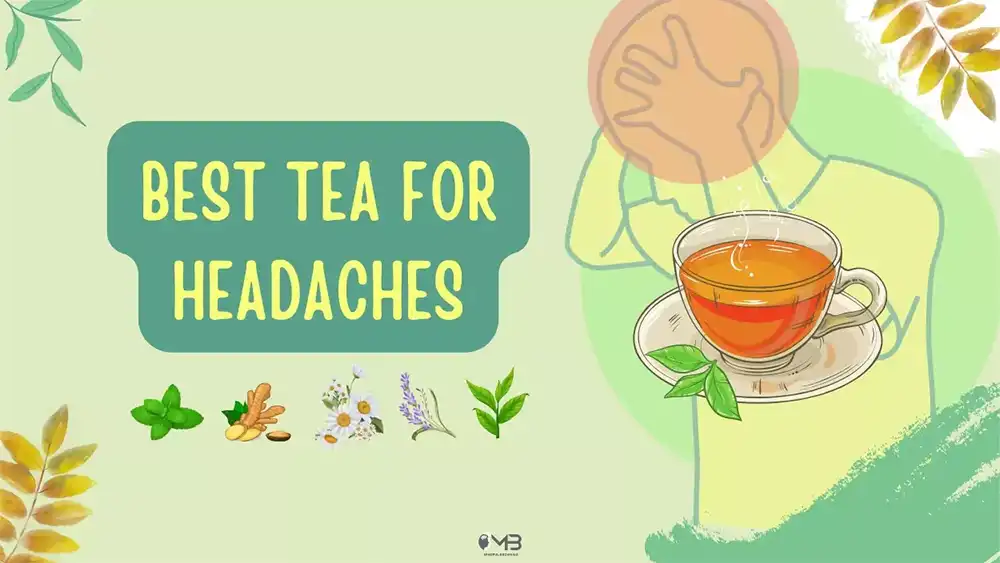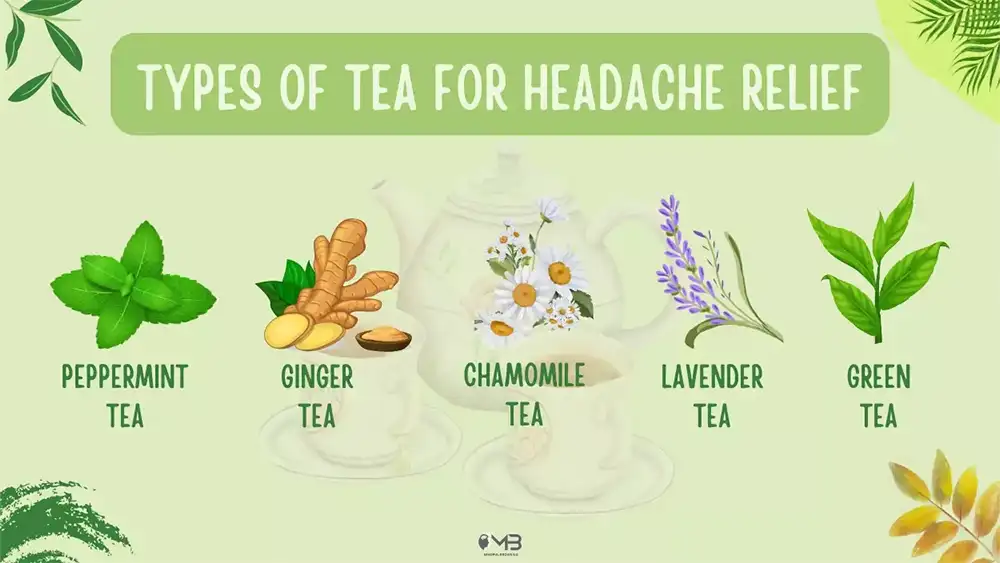
Tea is among the most consumed beverages globally, owing to its popularity in several countries worldwide. Several medical studies have shown that tea has certain anecdotal advantages, including being an effective relief for headaches and migraines.
Some teas, enriched with specific herbs and compounds. It has been shown to possess properties, like caffeine, that help reduce headache symptoms.
Read on to discover the best tea for headaches that is helpful to reduce tension and stress headaches after crying and relief from migraines.
Does Tea Help With Headaches. Here is How?
Tea is one of the best beverages to provide relief for headaches through various mechanisms. The ingredients in these teas, like caffeine, have specific properties that could help lessen the effects and relieve symptoms of headaches. Drinking a warm cup of tea can also help you reduce the throbbing pain in your head caused by migraines.
Here are some types of tea and what they contain to help relieve headaches and migraines.
| Tea Type | Key Ingredients | Benefits |
| Peppermint Tea | Peppermint leaves, Menthol | Peppermint is known for its muscle-relaxing properties, which can help ease tension headaches. Menthol, a key component, has a cooling effect that helps relieve headache pain. |
| Ginger Tea | Ginger root | Ginger has been shown to reduce the risk of migraine-related nausea and vomiting. |
| Chamomile Tea | Chamomile flowers | Chamomile is renowned for its calming effects. It helps relax the mind and body, reducing stress and tension that often contribute to headaches. |
| Lavender Tea | Lavender flowers | Lavender has soothing properties that help in relaxing the nervous system. Drinking lavender tea can reduce anxiety and stress, which are common triggers for headaches. |
| Green Tea | Green tea leaves, Caffeine | Green tea contains caffeine, which can help constrict blood vessels and reduce headache pain. It also has antioxidants that may help reduce inflammation and improve overall well-being. |
| Clove Tea | Whole cloves | Cloves have significant anti-inflammatory properties that can help alleviate headaches and provide a calming effect. |
6 Different Types of Tea for Headache Relief

1. Peppermint Tea
A study on peppermint found, that its ingredient, menthol, helps to relax the muscles around the head and neck, alleviating tension headaches that may come after napping in uncomfortable positions. Menthol’s soothing properties could potentially enhance migraine treatment and provide temporary relief.
Peppermint herbal tea is frequently combined with other herbs and spices, such as lavender and ginger, to boost its healing and therapeutic properties.
In addition to its potential for headache relief, peppermint tea can enhance alertness, soothe upset stomachs, and treat irritable bowel syndrome. It helps reduce stress and tension.
However, excessive use of peppermint tea can lead to digestive issues or heartburn, and its strong menthol content might exacerbate acid reflux in some individuals.
2. Ginger Tea
As per a 2021 study, ginger tea is good for the effects of pain and nausea, making it a popular option among natural remedies for headaches. A meta-analysis of 227 participants revealed that ginger increased the likelihood of patients being pain-free two hours after treatment.
Additionally, ginger was found to reduce the risk of migraine-related nausea and vomiting without raising the risk of adverse events. The natural oils in ginger contain compounds that act as antioxidants and effectively treat inflammation, nausea, and vomiting. Ginger can also boost serotonin levels, which helps manage migraine attacks.
Overconsumption of ginger tea can cause gastrointestinal discomfort, including bloating, diarrhea, and heartburn, and may interact with certain medications, increasing the risk of side effects.
3. Chamomile or Manzanilla Tea
Chamomile tea’s calming effects and medicinal nutrients make it ideal for reducing stress-related headaches. According to research from 2022, varieties of chamomile are used for therapeutic purposes. They are packed with beneficial components, including flavonoids, terpenoids, and coumarins, contributing to their wide range of medicinal properties.
This beverage effectively reduces inflammation, fights oxidative stress, alleviates pain from headaches from lack of sleep, combats microbial infections, protects the liver, addresses allergies, and offers potential anticancer and anti-hypertensive benefits.
Chamomile tea also contains flavonoids like apigenin, which merges with the brain’s benzodiazepine receptors, creating a sedative effect that calms nerves and reduces inflammation. It works almost similar to how magnesium in salt water helps in relieving nervous irritability.
Drinking chamomile tea in large amounts can potentially lead to allergic reactions or interact with blood-thinning medications, which may increase the risk of bleeding.
4. Lavender tea
Although there’s limited research on the effectiveness of lavender in headache and migraine relief, there are cases where it has been used to help attenuate symptoms.
Lavender’s essential oil has been employed as an anxiolytic to reduce anxiety, a mood stabilizer to enhance emotional balance, and a sedative to promote relaxation.
Additionally, lavender oil acts as a spasmolytic to ease muscle spasms, an anti-hypertensive to help lower blood pressure and an antimicrobial to fight infections. Its analgesic properties provide pain relief, and it also accelerates wound healing.
Excessive intake of lavender tea may result in nausea or headaches in some individuals and could interact with sedative medications, causing drowsiness.
5. Green tea
Like most forms of caffeinated tea, green tea can help reduce headache after eating that are often caused by constricting blood vessels. The tea is derived from the leaves of the Camellia sinensis plant. It’s celebrated not only for its subtle caffeine content but also for its rich antioxidant properties. Green tea is also used in skin rejuvenation practices like green light therapy.
Additionally, green tea is recommended as a much lighter but effective campaign source than coffee. According to FDA, an 8-ounce serving of green tea typically contains between 30 and 50 milligrams of caffeine. Gentler option than the 80 to 100 milligrams found in the same amount of regular coffee.
Many people take it as the best tea for anxiety as well. According to a study conducted in 2017, low-caffeine green tea can help students manage stress.
Drinking too much green tea can lead to insomnia due to its caffeine content. High levels of tannins might interfere with iron absorption, potentially causing nutritional imbalances.
6. Clove Tea
Cloves are known for their antioxidant properties. According to the research conducted by the Department of Biotechnology, Techno India University, this herbal tea has enhanced antimicrobial properties. In other words, you can safely consider it a medicinal beverage.
Sipping on clove tea can help ease tense muscles and kick headaches to the curb. The tea’s warmth and eugenol’s soothing powers work together to melt away the discomfort of headaches.
Cloves have a high reputation for treating respiratory ailments as well. That is why people who drink clove tea are less affected by flu and colds in general.
It can show allergic reactions in some people in the form of difficulty breathing, or swelling of the face and throat. Experts suggest consuming it in moderate amounts as it can cause nausea or stomach pain in some cases.
What is Right Tea for Headaches?
Finding the best tea for headaches largely depends on your needs and preferences. Herbal teas like peppermint and chamomile are renowned for their alleviating properties. They have the potential to ease tension headaches, while ginger tea can help with nausea often associated with migraines. With its moderate caffeine content and antioxidant benefits, green tea may also offer relief and prevent headaches for some.
Let’s Wrap up!
Ultimately, the most effective tea will align with your symptoms and complement your overall wellness routine. Experimenting with different varieties. Paying attention to how your body responds can guide you toward the perfect cup that provides the relief you need.






